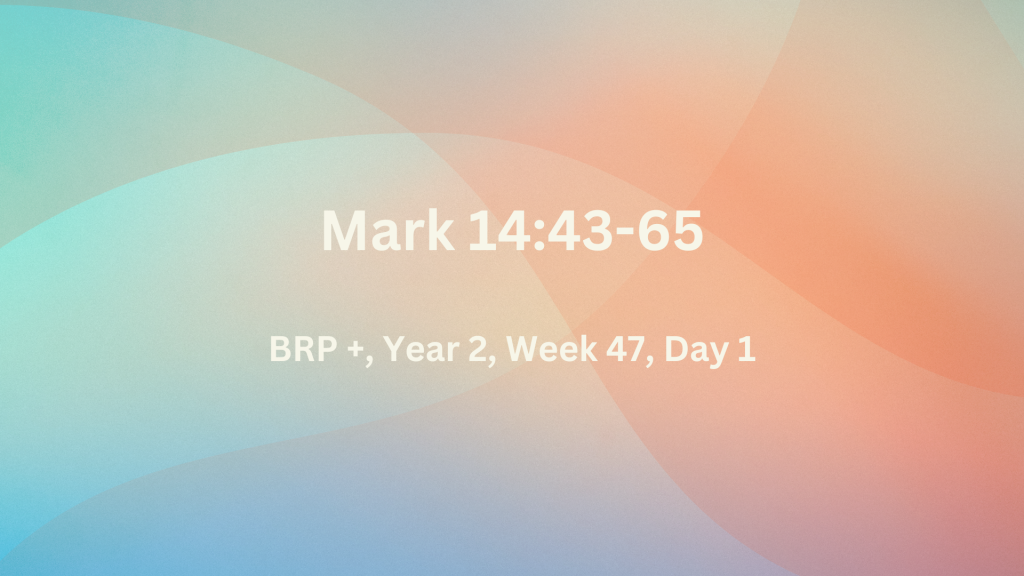Mark 14:43-65
Q.1. When was Jesus arrested and by whom? Why did Judas kiss Jesus? How did His disciples respond? What did Jesus say about His arrest? Why did He submit to His arrest? – (Mk.14:14:43-52)
The disciples were unaware of the unfolding crisis. However, Jesus knew from the Scriptures exactly what would befall Him. After the agony of Gethsemane, He announced to His disciples – behold, the one who betrays Me is at hand (Mk.14:42). A – Roman cohort and officers from the chief priests and the Pharisees … armed with swords and clubs came to arrest Him (Mk.14:43; Jn.18:3). Judas stepped out of the darkness and kissed Jesus, as agreed, to identify the One to be arrested (Mk.14:44-46). In the confusion, one of the disciples cut off the ear of the high priest’s servant (i.e. Peter – c.f. Jn.18:10). The rest, including Mark who escaped while almost naked, fled, and left Jesus. (Mk.14:50-52 c.f. Mt.26:31). Jesus highlighted the folly of the arresting officers -48 Have you come out with swords and clubs to arrest Me, as you would against a robber. 49 Every day I was with you in the temple teaching, and you did not seize Me; but this has taken place to fulfill the Scriptures (Mk.14:48-49). He meekly gave Himself over to His captors, thus fulfilling the Scriptures.NOTE: According to the Old Testament Law, there could only be one High Priest functioning in Jerusalem at any one time (Exo.30:10; Heb.9:6-7). Who then were these chief priests (plural) who are mentioned sixty-two times in the New Testament? To gain greater control over Judea, Herod the Great (37-4 B.C.) circumvented the authority of the High Priest. He appointed chief priests from the aristocracy, with whom he dealt politically. This suited the Romans with the day-by-day administration of Judea, and it secured their tax revenue. Religiously, the High Priest still held sway over Judaism, particularly because Annas was the father-in-law of Caiaphas. Caiaphas was the High Priest under whom Jesus was condemned (c.f. Mt.26:57; Jn18:13). Annas and Caiaphas were Sadducees who wielded enormous power, increased by their marriage alliance, over Judaism. (c.f. Acts 5:17). Annas was the appointed High Priest who tried Peter and John (c.f. Acts 4:6). Consequently, the Gospel writers refer to a High Priest, chief priests, elders, and Scribes as part of the Council who condemned Jesus (Mk.14:53, 55, 60, 63).
Q.2. Where was Jesus taken? What did Peter do? What did the chief priest try to do? Why could they make little progress? How did Jesus respond to their accusations? Why? – (Mk.14:53-61)
Jesus was taken to a hastily convened meeting of the Sanhedrin that included – the High Priest; and all the chief priests and the elders and the scribes … (Mk.14:53 c.f. Mk.14:55). Peter followed Jesus into the courtyard of the High Priest – at a distance (Mk.14:54). The trial of Jesus had nothing to do with justice or finding the truth, as – the whole Council kept trying to obtain testimony against Jesus to put Him to death, and they were not finding any (Mk.14:55). Many gave false testimonies and charged Him with claiming – I will destroy this temple made with hands, and in three days I will build another without hands (Mk.14:58). Jesus – kept silent and did not answer (Mk.14:61). He knew that these questions were framed in such a way as to accuse Him of guilt.
Q.3. What question did Jesus answer? Why did He quote from the Scriptures? Why did the High Priest tear his robes? What did the Sanhedrin conclude? How did they treat Him? – (Mk.14:61-65)
The High Priest then placed Jesus under oath to reply – Are You the Christ, the Son of the Blessed One? (Mk.14:61 c.f. Mt.26:63). Jesus prefaced His response – If I tell you, you will not believe (c.f. Lk.22:67). He then quoted the Scriptures – I am. And you shall see the Son of Man sitting at the right hand of Power and coming with the clouds of heaven (Dan.7:13 c.f. Ps.110:1). It was a clear claim to deity. The irony was that the governing Council of the Jews convicted Him for who He was. The High Priest refused to believe, closed the mock trial, tore his priestly robe, and concluded – ‘You have heard the blasphemy; how does it seem to you’? And they all condemned Him to be deserving of death (Mk.14:64). They then humiliated Jesus, spat on Him, and beat Him with their fists (Mk.14:65). It was a miscarriage of justice, with a Sanhedrin of attendees who had already decided to put Jesus to death. It is not possible that either the Chief Rabbi, Nicodemus, or Joseph of Arimathea had been invited (Mk.15:43 c.f. Jn.3:10; 19:38-39).

